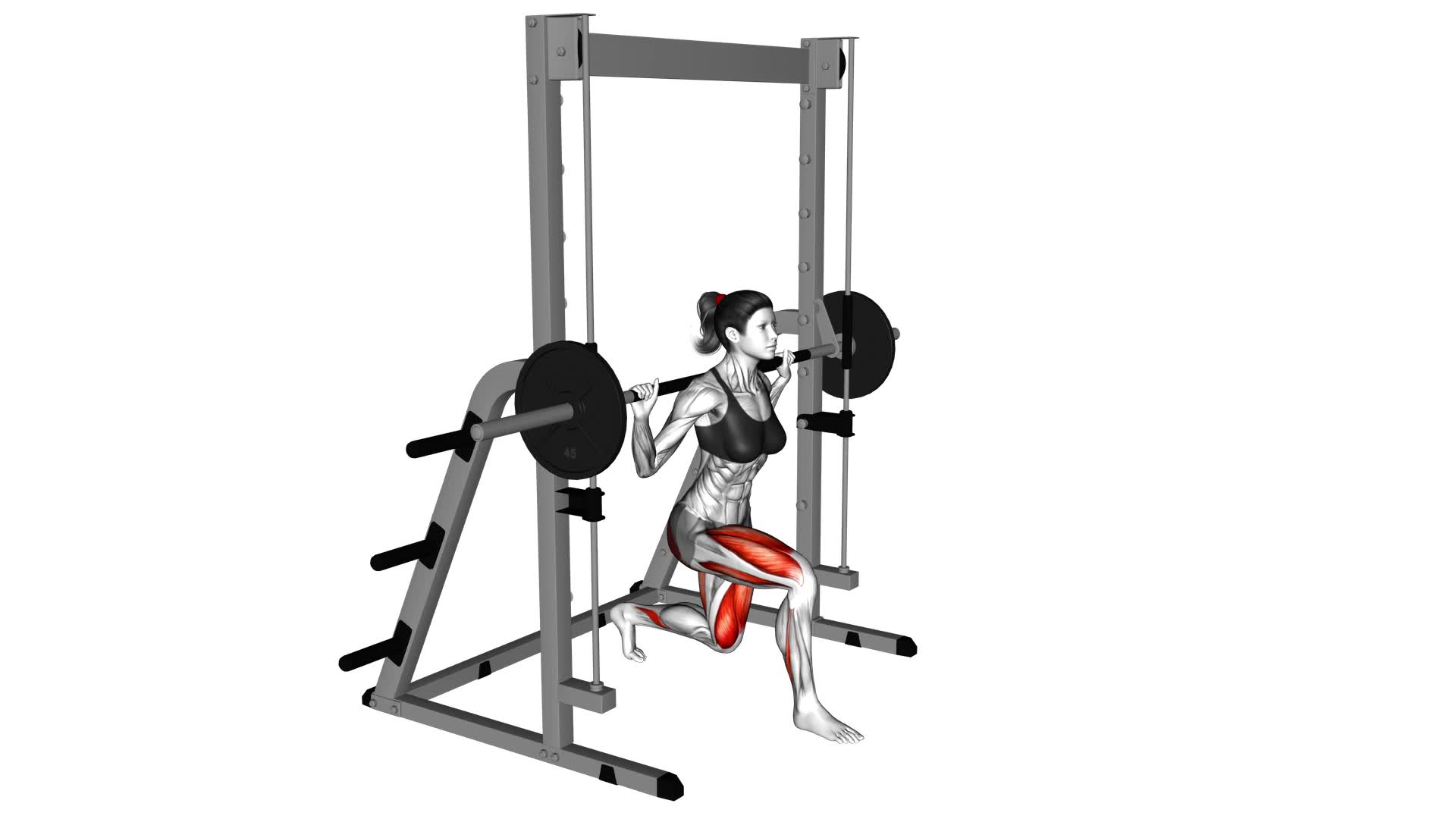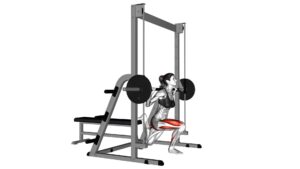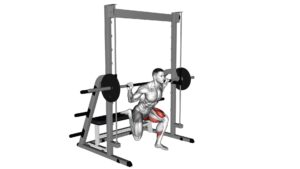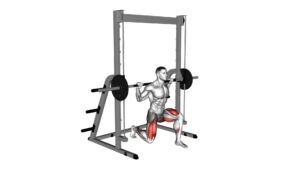Smith Split Squat (female) – Video Exercise Guide & Tips

Are you looking for a new lower body exercise to add to your fitness routine? Look no further than the Smith Split Squat.
Watch This Exercise Video
This exercise targets your quads, glutes, and hamstrings, helping you build strength and stability.
In this video exercise guide, we'll show you the proper form and technique, as well as variations and modifications to try.
Get ready to take your workout to the next level with the Smith Split Squat.
Let's get started!
Key Takeaways
- The Smith Split Squat targets the quads, glutes, and hamstrings, helping to build strength and stability in the lower body.
- Proper form and technique are important, including maintaining correct body alignment, keeping the back straight, and avoiding common mistakes such as extending the knee beyond the toes or leaning too far forward.
- Maintaining proper technique is crucial for preventing strain on joints and muscles, targeting the intended muscles effectively, minimizing the risk of injury, and maximizing muscle activation and overall gains.
- Variations and modifications, such as using different foot positions, adding weights, or incorporating balance challenges, can be used to target different muscle groups and increase the difficulty of the exercise.
Benefits of the Smith Split Squat
Discover the benefits of the Smith Split Squat for improving lower body strength and stability.
The Smith Split Squat is an effective exercise that targets multiple muscle groups in the lower body, including the quadriceps, hamstrings, glutes, and calves. By performing this exercise with proper form, you can experience several weightlifting benefits.
One of the main advantages of the Smith Split Squat is its ability to increase lower body strength. This exercise requires you to stabilize your body while performing a lunge-like movement, which engages the muscles in your legs and hips. As a result, your quadriceps and hamstrings are strengthened, allowing you to perform other weightlifting exercises more effectively.
Additionally, the Smith Split Squat enhances lower body stability. As you balance on one leg and lower your body down, you're forced to engage your core muscles for stability. This not only improves your balance but also strengthens the muscles in your hips and glutes, which are essential for maintaining proper posture and preventing injuries.
Proper Form and Technique
To perform the Smith Split Squat with proper form and technique, it's crucial to focus on correct body alignment. Keep your back straight, shoulders back, and core engaged throughout the exercise.
Additionally, be mindful of common mistakes such as allowing your knee to extend beyond your toes or leaning too far forward.
Correct Body Alignment
To achieve correct body alignment in the Smith Split Squat exercise, make sure that your spine is straight and your shoulders are squared. Here are some key points to keep in mind:
- Keep your feet hip-width apart, with one foot positioned forward and the other foot back.
- Bend your front knee, ensuring that it stays directly above your ankle and doesn't extend past your toes.
- Engage your core muscles by pulling your belly button towards your spine.
- Maintain a neutral pelvis, avoiding excessive arching or rounding of your lower back.
By following these tips, you can ensure proper technique and body alignment in the Smith Split Squat exercise.
Remember to focus on maintaining good form throughout the movement to maximize the benefits and minimize the risk of injury.
Avoid Common Mistakes
Make sure you maintain proper form and technique to avoid common mistakes in the Smith Split Squat exercise. By avoiding these mistakes, you can maximize the effectiveness of your workout and reduce the risk of injury.
One common mistake isn't keeping your back straight throughout the movement. It's important to engage your core and keep your spine aligned to ensure proper form.
Another mistake isn't going low enough in the squat. To get the most out of this exercise, make sure your front knee is at a 90-degree angle and your back knee is hovering just above the ground.
Lastly, avoid leaning too far forward or backward. Keep your weight evenly distributed on both legs to maintain balance and stability.
Importance of Proper Technique
Maintaining proper form and technique is crucial for the Smith Split Squat exercise. It ensures optimal results and reduces the risk of injury. Here are the key reasons why technique is important and the benefits of proper form:
- Stability: Proper technique allows you to maintain stability throughout the exercise, preventing unnecessary strain on your joints and muscles.
- Targeted Muscles: By using the correct form, you can effectively target the muscles you intend to work, such as the quadriceps, glutes, and hamstrings.
- Injury Prevention: Following proper technique helps to minimize the risk of injury. It promotes safe movement patterns and reduces stress on vulnerable areas.
- Maximized Results: When you perform the exercise with proper form, you engage the targeted muscles more effectively. This leads to better muscle activation and overall gains.
By understanding the importance of technique and the benefits of proper form, you can ensure that you get the most out of your Smith Split Squat exercise.
Now, let's transition into the subsequent section about how to set up the smith machine.
How to Set up the Smith Machine
You often use the Smith Machine for your workouts, so let's see how you can set it up properly. Properly setting up the equipment is important for your safety and to ensure an effective workout.
To begin, make sure the Smith Machine is placed on a level surface. Adjust the safety catches to an appropriate height, ensuring they're within reach but not too low to interfere with your movement. The safety catches are there to catch the weight in case you're unable to complete a rep.
Next, load the desired weight onto the barbell. Start with a lighter weight if you're new to using the Smith Machine or if you're unfamiliar with the exercise you plan to perform. Gradually increase the weight as you gain strength and confidence.
When positioning yourself for the exercise, stand facing away from the machine and grip the barbell with an overhand grip. Make sure your feet are shoulder-width apart and your knees are slightly bent.
Lastly, before starting your workout, take a moment to familiarize yourself with the movement and range of motion required for the exercise you'll be performing. This will help you perform the exercise correctly and avoid any potential injuries.
Variations and Modifications
There are several variations and modifications you can try to make the Smith Split Squat exercise more challenging or targeted to specific muscle groups.
One option is to vary your foot positions, such as placing one foot farther forward or to the side.
You can also add weights, such as dumbbells or a barbell, to increase the resistance and intensity of the exercise.
Different Foot Positions
To vary and modify the Smith Split Squat (female), experiment with different foot positions. Here are some options and the benefits of each:
- Narrow stance: Place your feet closer together, about hip-width apart. This position emphasizes targeting your quadriceps and inner thighs, helping to improve stability and balance.
- Wide stance: Spread your feet wider than hip-width apart. This position places more emphasis on your glutes and outer thighs, helping to strengthen and shape these areas.
- Heel elevated: Place your front foot on a slightly elevated surface, such as a step or weight plate. This position increases the range of motion and activates your calf muscles, providing a deeper stretch and improved ankle mobility.
- Toe elevated: Elevate your back foot by placing your toes on a step or weight plate. This position targets your quadriceps and challenges your balance and stability.
By experimenting with different foot positions, you can target specific muscle groups and add variety to your Smith Split Squat routine.
Now, let's move on to the next section and discuss the use of weights.
Use of Weights
Continuing from the previous subtopic, let's explore different variations and modifications of the Smith Split Squat using weights.
The use of dumbbells is a great way to add intensity and challenge to your workout. Holding a dumbbell in each hand can increase the resistance and help build strength in your lower body. You can start with lighter weights and gradually increase as you become more comfortable and stronger.
Additionally, there are alternative exercises that you can try to target similar muscle groups. Lunges with dumbbells, Bulgarian split squats, and step-ups with weights are all effective options. These exercises provide variety and can help prevent boredom in your routine.
Now, let's move on to the next section where we'll discuss balance challenges.
Balance Challenges
To enhance your workout and challenge your balance, try incorporating balance challenges into your Smith Split Squat routine. Balance training is an important aspect of fitness that can improve your stability and overall performance. Here are some stability exercises you can try:
- Single-leg Smith Split Squats: Perform the split squat while balancing on one leg. This will engage your core and challenge your balance even more.
- Bosu Ball Split Squats: Place one foot on a Bosu ball while performing the split squat. The unstable surface will require you to engage your stabilizing muscles.
- TRX Split Squats: Hold onto TRX straps while performing the split squat. This will add an element of instability and challenge your balance.
- Medicine Ball Split Squats: Hold a medicine ball in front of your chest while performing the split squat. The added weight will increase the challenge on your balance.
Incorporating these balance challenges into your routine will help improve your stability and take your Smith Split Squat workout to the next level.
Common Mistakes to Avoid
Avoid these common mistakes when performing the Smith Split Squat exercise to prevent injuries and ensure an effective workout.
First, avoid allowing your front knee to move past your toes during the lunge. This places excessive strain on the knee joint and increases the risk of injury. Instead, focus on keeping your front knee in line with your ankle throughout the movement.
Another common mistake is neglecting to engage your core muscles. Without proper core activation, you may experience lower back pain and instability during the exercise. To avoid this, actively tighten your abdominal muscles and maintain a neutral spine position throughout the movement.
Additionally, beginners often struggle with balance and stability in the Smith Split Squat. To modify the exercise and improve stability, start by using lighter weights or no weights at all. This will allow you to focus on maintaining proper form and balance before progressing to heavier weights.
Lastly, avoid rushing through the exercise or using momentum to complete the movement. This not only reduces the effectiveness of the exercise but also increases the risk of injury. Instead, focus on controlled and deliberate movements, ensuring proper form and technique.
Tips for Maximizing Your Workout
To maximize your workout, focus on engaging your glutes and maintaining proper form during the Smith Split Squat exercise. Here are some tips to help you maximize your results and incorporate resistance effectively:
- Position your feet shoulder-width apart, with one foot forward and the other foot back on the Smith machine. This stance will help activate your glutes and target your quadriceps.
- Keep your chest up and your back straight throughout the exercise. This will help maintain proper alignment and prevent any strain on your lower back.
- As you lower your body into the squat position, make sure your front knee stays aligned with your ankle. Avoid letting it cave inwards, as this can put unnecessary stress on your knee joint.
- Push through your front heel as you return to the starting position. This will help engage your glutes and give you a more powerful and effective movement.
By following these tips and focusing on engaging your glutes and maintaining proper form, you can maximize the effectiveness of your Smith Split Squat exercise.
Remember to start with lighter weights and gradually increase the resistance as you get stronger.
Frequently Asked Questions
How Many Calories Does the Smith Split Squat Burn?
The Smith Split Squat is a great exercise for burning calories and improving balance. By incorporating this exercise into your workout routine, you can expect to burn a significant amount of calories.
Not only does this exercise target your lower body muscles, but it also engages your core and improves stability.
Can the Smith Split Squat Help Improve Balance?
The Smith split squat can be a great exercise to improve your balance and stability. By incorporating this exercise into your routine, you can work on strengthening the muscles in your legs and core that are essential for maintaining balance.
Additionally, there are variations of split squats that you can try, such as Bulgarian split squats, which further challenge your balance and stability.
What Are the Primary Muscles Targeted During the Smith Split Squat?
The primary muscles targeted during the smith split squat are your quadriceps, hamstrings, and glutes. By incorporating this exercise into your routine, you can effectively strengthen your legs and improve overall lower body strength.
Additionally, there are variations of the smith split squat that can be performed to add an extra challenge and further target specific muscles. These variations can help you progress and continue to see benefits in terms of leg strength and stability.
Is the Smith Split Squat Suitable for Beginners?
The Smith Split Squat is a great exercise for beginners to improve lower body strength. By incorporating modifications, such as using lighter weights or performing the exercise with body weight only, you can tailor it to your fitness level.
This exercise targets the quads, glutes, and hamstrings, helping to build muscle and increase stability. Incorporating the Smith Split Squat into your workout routine can provide numerous benefits for your lower body strength.
How Often Should the Smith Split Squat Be Incorporated Into a Workout Routine for Maximum Results?
For maximum results, it's important to incorporate the Smith split squat into your workout routine with the right frequency.
This exercise is great for strength training and can help you build strong lower body muscles.
To get the most out of it, aim to do the Smith split squat at least 2-3 times a week.
This will allow your muscles to recover while still challenging them enough to promote growth and improvement.
Conclusion
In conclusion, the Smith split squat is a highly effective exercise for women that targets the lower body muscles. By maintaining proper form and technique, and using the Smith machine correctly, you can maximize the benefits of this exercise.
Additionally, variations and modifications can be made to cater to individual fitness levels and goals. Avoiding common mistakes and following the provided tips will help you get the most out of your workout.
Incorporate the Smith split squat into your routine for stronger and more toned legs.

Author
Years ago, the spark of my life’s passion ignited in my mind the moment I stepped into the local gym for the first time. The inaugural bead of perspiration, the initial endeavor, the very first surge of endorphins, and a sense of pride that washed over me post-workout marked the beginning of my deep-seated interest in strength sports, fitness, and sports nutrition. This very curiosity blossomed rapidly into a profound fascination, propelling me to earn a Master’s degree in Physical Education from the Academy of Physical Education in Krakow, followed by a Sports Manager diploma from the Jagiellonian University. My journey of growth led me to gain more specialized qualifications, such as being a certified personal trainer with a focus on sports dietetics, a lifeguard, and an instructor for wellness and corrective gymnastics. Theoretical knowledge paired seamlessly with practical experience, reinforcing my belief that the transformation of individuals under my guidance was also a reflection of my personal growth. This belief holds true even today. Each day, I strive to push the boundaries and explore new realms. These realms gently elevate me to greater heights. The unique combination of passion for my field and the continuous quest for growth fuels my drive to break new ground.







